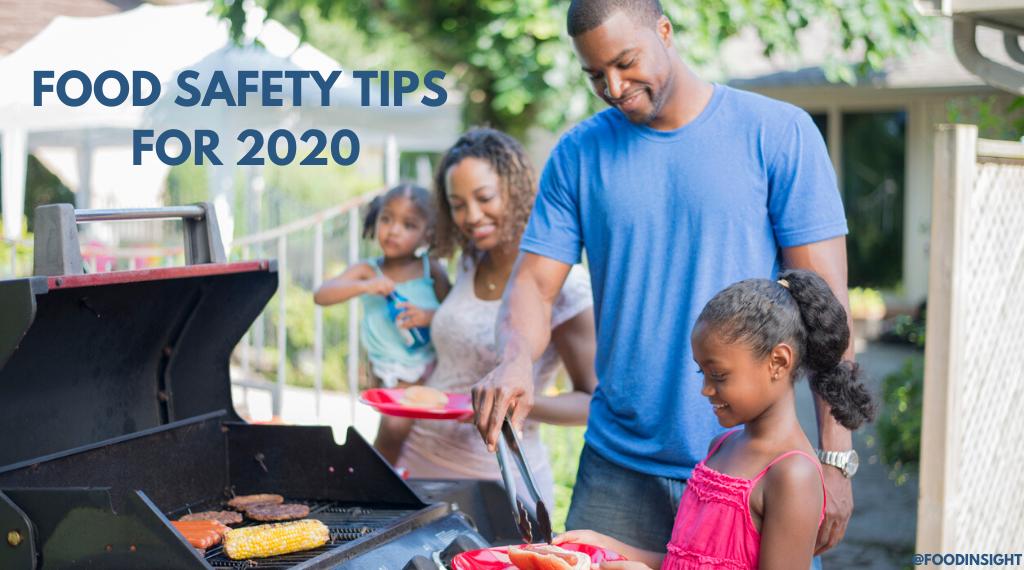As we celebrated World Food Safety Day on June 7th this year—in the midst of a global pandemic—it’s now more important than ever for us to think about how to safely buy, prepare and serve our food. Indeed, COVID-19 has altered forever how we view the safe acquisition, handling, and management of our food supply. Recent IFIC data shows that about one-third of us (36%) are buying more packaged foods and thinking more about personal hygiene, with half of us (52%) washing our hands after going to the grocery store.
Being invested in how our food is packaged and keeping our hands clean are not only important topics of concern during a pandemic; they also play key roles in reducing our risk of foodborne illness. In fact, one in ten people worldwide fall ill from contaminated food every year. In the United States, an estimated one in six Americans contract foodborne illness annually, leading to 128,000 hospitalizations and 3,000 deaths.
Here are four key tips for keeping ourselves and our food safe during the COVID-19 pandemic and for years to come:
1. Have smaller gatherings and events outdoors to promote social distancing. With kids out of school and summer rolling in, many of us may look to take vacations, visit friends and loved ones, or host or attend more social gatherings. Since the virus that causes COVID-19, like many other germs, spreads mainly through person-to-person contact, your most important line of defense against germ transfer is to practice appropriate social distancing. Keeping six feet apart, having fewer than ten people at your event, and attending gatherings outside are all ways to enjoy socializing in a safe manner.
Another great way to minimize contact is to think about how food and beverages are served when gathering. When hosting or attending events, avoid buffet-style meals and opt for personal portions to reduce the risk of COVID-19 transmission. Instead of sharing beverages, bring your own beverage to reduce “buffet-drinking.” While there is no current evidence to support the transmission of COVID-19 by food, you should still always practice safe food–handling principles to reduce germ transfer and your risk of foodborne illness.
2. Adhere to the core four food safety principles of clean, separate, cook, and chill. For prepping meals at home, these are some measures you should take to stay safe and reduce your risk of foodborne illness. These cleanliness practices also help minimize the transfer of any potential coronavirus presence, too.
Clean: Washing your hands is always important to reduce any germ transfer—either from you to a food or vice versa. Keeping your preparation surfaces clean by disinfecting them with an EPA-registered disinfectant is a good practice as well. However, be sure not to use detergents or disinfectants to clean fruits or vegetables; they can make you sick. Instead, opt for cool running water to rinse your fruits and vegetables.
Separate: Raw meat, poultry, seafood and eggs can spread germs like Salmonella and E. coli to ready-to-eat foods if you don’t separate them. Avoid cross-contamination during food prep by preparing fruits and vegetables before raw meat and poultry. And be sure to keep raw meat, poultry, and seafood away from other foods in the fridge.
Cook: Cooking foods to the proper temperature helps kill foodborne illnesses like Salmonella, E. coli, and Campylobacter. The only way to determine if your food is safely cooked is to use a food thermometer; using subjective indicators like color and texture is not reliable.
Chill: Refrigerate or freeze meat, poultry and other perishables upon returning from the grocery store to slow the growth of harmful bacteria. When thawing frozen foods, use the refrigerator, cold water or the microwave.
3. Use contactless delivery or pick-up when ordering out to minimize person-to-person contact. Many of us may not be big on cooking or may want to have food delivered to our homes. Getting food from your favorite place can still be a safe option. There is no evidence that transmission of COVID-19 occurs through food, food containers or food packaging; but, by minimizing the amount of contact points using contactless delivery or pick-up, you are reducing the number of touch points and maintaining social distancing. For concerns about food packaging or containers, the FDA recommends washing your hands after handling the food packaging, after removing the food from the packaging, and before you eat. Washing your hands is always a healthy habit to practice, regardless
4. Practice preventive actions whenever possible to avoid spreading germs that can contribute to the spread of COVID-19. For our last tip, here are some best practices that are not food-related specifically but are important for reducing germ transfer during the ongoing coronavirus pandemic. This includes staying home when you are feeling sick, covering your coughs and sneezes with a tissue and properly tossing the tissue away in the trash, and washing your hands with soap for at least 20 seconds (especially after a sneeze or after touching your face or other surfaces that can carry germs or dirt). In public settings such as grocery stores, pharmacies, and other areas where social distancing measures are difficult to maintain, follow CDC recommendations to wear a cloth face covering.
Food safety is a priority from farm to fork for producers, manufacturers, retailers and the public. By following the tips above, you’ll be doing your part. Just remember to practice the four core food safety principles and CDC preventive actions and you’ll be on your way to minimizing the risk of both COVID-19 and foodborne illness.
This article was written by Minh Duong, MS, IFIC’s 2020 Sylvia Rowe Fellow
